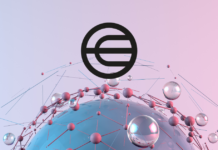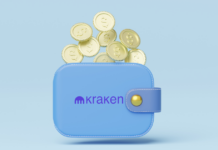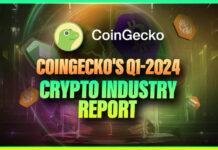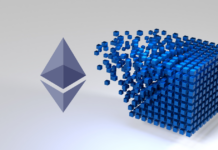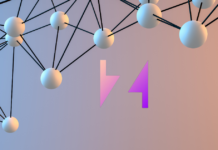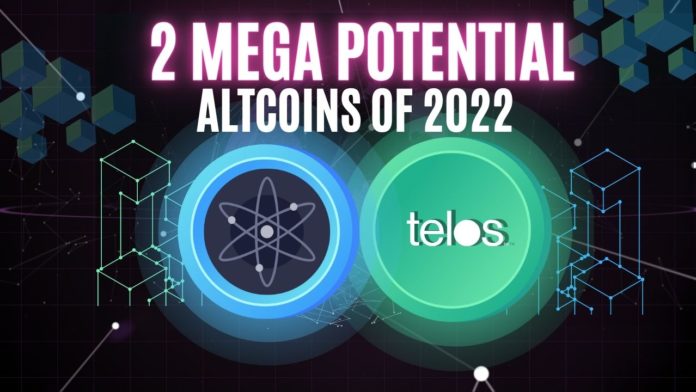Volatility, traditionally associated with cryptocurrencies has been on full display in recent months. In Jan 2022, the market cap plummeted 40%, wiping out more than $1.2 trillion. So when a project of two dollars that a strong downward trend, there must be a reason.
Right? I mean if every project is losing money and something else isn’t, that’s not an accident. And we’ve found 2 great projects that are bucking the trend. They have been flat or even higher since mid-December. And you might have already come across them: These are Telos & Cosmos.
Therefore, in this article, you will learn why these quality projects are maintaining their value when most of the market is losing it. We will start describing Cosmos.
What is Cosmos?
Cosmos is an unbelievably successful project as measured by its goal of being the Internet of Blockchains. Their ecosystem is huge. As it bills itself as the internet of blockchains. That tells you what they are about. Interoperability.
Some of the best and most popular blockchain projects run on Cosmos. Projects like Binance Smart Chain, Terra, Crypto.com, among others. It’s borderline shocking how many huge projects run on Cosmos. Therefore, to be precise almost 260 different apps and chains run on the Cosmos system.
And not only that. At least 3 of these projects are worth more than Cosmos.
The heart of their value proposition is 3 things:
- The Cosmos Hub
- The Cosmos IBC
- And the Cosmos SDK
Moreover, the Cosmos Hub is the main blockchain or as fans of Polkadot like to say the Layer Zero. This is the chain that connects to all the other chains. Those other chains, called the Interchain, communicate with each other and with the Cosmos Hub through their IBC. The chains themselves are called application-specific blockchains.
IBC, which stands for Inter-Blockchain Communication and Cosmos underlying technology Tendermint BFT (Byzantine Fault Tolerance) are the tech tools that allow Cosmos to build their Internet of Blockchains. Therefore, IBC is like TCP/IP, only about connecting the chains via communication. Tendermint is the PoS consensus mechanism.
More About Cosmos
On the other hand, the SDK or Software Development Kit is vital too. After all, you can’t have lots of blockchains built on your ecosystem if they are hard to build. And on Cosmos, it’s really easy to build a new chain.
Moreover, the SDK uses ‘composable modules’ meaning that thanks to its open-source nature. Then, someone else may have already built a quality module that you can just add to your new chain. Therefore, all chains using the SDK have Tendermint for consensus built into them already too.
The language in the SDK is Golang. It’s a popular widely accepted programming language meaning many programmers at many different levels can build using the Cosmos SDK. For those interested in decentralized stablecoins, at least 2 of them UST on Terra and USDX on Kava are both running on Cosmos SDK in their chains.
🔊Hello #TelosCommunity!
The #Telos Core Developers are excited to share our development updates. Read all about how we are refining our web wallet, Telos ID, and the strides we're making with Open Block Explorer! 🟣Catch up on all the action here: 👉👉 https://t.co/3PKnF2SLCK pic.twitter.com/aHhTmor1mA
— The Telos Foundation (@HelloTelos) February 11, 2022
Cosmos Tokenomics
As you just saw in our analysis of their Ecosystem, Cosmos is undoubted, a very successful project. The team held an ICO in April 2017, raising $17.3 million in just 28 minutes as they sold 168 million ATOM tokens at $0.098 each.
And even after so much usability and adoption, it is still the 20th largest crypto project by market cap. Yet, that seems like it’s not big enough. Not when BSC, Terra, and Crypto.com, the projects built on Cosmos are all ranked higher in market value than Cosmos is.
Also, you can stake Cosmos’s native coin, $ATOM, and earn 9.7% APY. Doing so, like staking on other chains helps to keep it secure. Moreover, staking is also ATOM, which is generated for the ecosystem.
On the other hand, according to CoinGecko, the current circulating supply of Cosmos is 288.2 million ATOM tokens. At the current price of $28.3, the market cap is $8.1 billion. Also, the total supply is a harder number to get at although their ATOMScan block explorer says inflation is 9.34% per year right now. Based on a recalculation each block and how much ATOM is staked determines what the emission rate for new ATOM will be.
ATOM Price Prediction
According to the price prediction analysis, ATOM is currently trading at $28.3 just under the support zone at $28.78. If it moves up and holds above the $28.78 support, we could start seeing a move towards $32.85, $35.37, $39.44, and $46.02.
If the resistance at $46.02 breaks, we could see a move towards $56.67 and $73.91. Failure to move to the support at $28.78 and hold above it could lead to a drop towards $25.02, $22.46, and $18.07.
If this gets you interested you can buy ATOM on Binance, as well as HitBTC, FMFW.io, Osmosis, Coinbase, Kraken, Huobi, Gate.io, and Digifinex. It’s widely available. Now, let’s talk about Telos.
What is Telos?
Telos says what they are right on the front of their website. Home of the Fastest Ethereum Virtual Machine. Therefore, Telos is the first EVM-compatible blockchain built on EOS.IO, the open-source blockchain that’s the basis for EOS.
And while EOS has been a controversial project, there’s total agreement on the quality and power of the EOSIO software.
Like Avalanche, Telos runs its smart contract platform separately on their C-Chain, Telos has 2 chains: Their Native Chain and the EVM Chain. This allows their EVM chain to run separately, fast, and light on resources, meaning great performance.
One of their more interesting features that makes their chain so fast is how Validators work. In other blockchains, transactions go into blocks, where depending on capacity, are processed. This means that some transactions can take longer to confirm.
However, In Telos, node validators process transactions in the same order they come in. This guarantees that transactions get fast execution with almost no costs. Here are some other different features that Telos offers in its blockchain:
- Worker Proposal System: accounts earn rewards for proposing improvements.
- Block Producer (BP) Rewards: Telos rewards block producers. The BPs in the Top 21 earn bonuses for keeping the network fast and secure
- Initial Token Balance Equity: This limitation of 40k TLOS tokens to start reduces the ‘whale’ factor
- No Voting in Exchanges: In Telos, exchanges can’t vote with their user’s TLOS tokens. We love this feature.
- Block Producer Accountability: To verify that Telos’ infrastructure is working properly, block producers must pass an inspection. They suffer a penalty if they fail.
More About Telos
Like Cosmos, Telos makes it easy to build in their ecosystem and developers have the following tools:
- Github repositories
- Telos Studio IDE where developers can deploy smart contracts directly
- Excellent APIs and SDK to use
When we compare Telos against the leading projects in the crypto space, we see a lot of potentials and that is what is keeping the project going strong in this highly volatile market too.
Did you know that the TPS of Telos beats Polkadot, Avalanche, Cardano by a big difference? Even it’s block time. What’s more interesting is that compared to these giants Telos has a very low marketcap which means even with a small influx of investors, the price will shoot up exponentially.
Here is why 2022 is the year of #Telos ! 🧐🧐 Plus, it also stops front running DEAD, is community governed & just launched both a new grant program AND a hackathon ! Great things to come ! 🤑🤑 #cryptocurrency #EVM #ETH #SOL #ADA pic.twitter.com/dbY3twlPQu
— 🟣 Tom (@TomTomCrypto) February 8, 2022
And that is what our price prediction tells us too. On Feb 7, a week back TLOS touched a new ATH. Its down almost 33% from its ATH and is trading close to $0.96. From here if it moves to $1.15 and holds on to the resistance we could see it moving towards $1.54 and $2.17. But before that, it needs to move over $1.15.
Telos Ecosystem
Telos is just starting to launch dApps on their native chain. So you are getting in early if you like Layer 1 blockchains for investment.
Some of those apps include:
1- OmniDex: The first native DEX on Telos which has a bridge, farms, and staking with up to 808% APY.
- tofyNFT: The largest NFT marketplace in BSC which is also working in Telos. This platform has recently partnered with the Bored Ape Kid club.
- ArisDAO: This is the first DAO reserve currency on Telos.
- AreaX NFT Marketplace: This platform is brand new. Recent launch
- T-Starter: The first IDO launchpad in Telos. This platform is also working in WAX and EOS.
The Telos network is flexible, fast, and you can even peg BTC and ETH to help with scaling issues ETH has.
Telos Tokenomics
Telos has a native token called TLOS which is currently trading at $1.05. In the last 12 months, TLOS has grown by 3000%. Its marketcap is $269 million and has a 24-hour trading volume of $4.7 million.
Also, its circulating supply is 255 million tokens which represent 71% of the total supply. You can buy TLOS in Gate.io, MEXC Capital, KuCoin, Hoo.com, and BKEX
On the other hand, the relationship between marketcap and TVL in Telos is 1.7. This is higher than blockchains like Moonriver or Tron at 1.6 and 1.5. Yet, this is a good sign because there are more funds in the token holders than in the smart contract. This means that the token may see adoption faster than others. It’s still lower valued by TVL than many other chains.
Also, according to LunarCrush, TLOS is in the top 10 coins with high social engagement in January 2022. So people are starting to notice what Telos is doing.
TOP 10 COINS BY LUNARCRUSH ALTRANK$MANA $KNC $FIDA $LUNA $SAND $TLOS $PYR $ATLAS $NEAR $COCOS pic.twitter.com/dhSDIYGSNs
— PHOENIX (@pnxgrp) January 31, 2022
Conclusions
So there you have it. Two great projects that are not just beating the downtrend of today’s market but are gaining in value. With Cosmos, you have an ecosystem so huge that there are projects in it worth more than Cosmos itself is worth.
On the other hand, with Telos, you have the best features of a few different chains like:
- Avalanche for its treatment of its smart contract platform
- and fast and energy-efficient features like Tezos and Cardano.
And both trade at discounts to their peers in Layer 1 (or Zero).
Join us on Telegram to receive free trading signals.
For more cryptocurrency news, check out the Altcoin Buzz YouTube channel.


